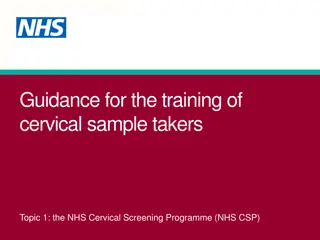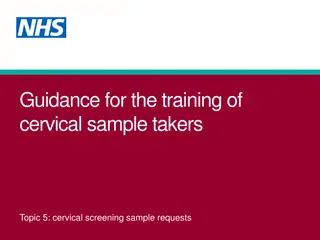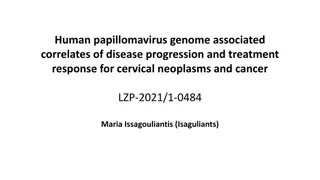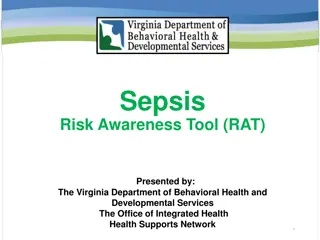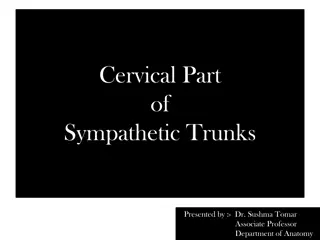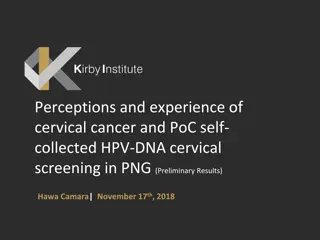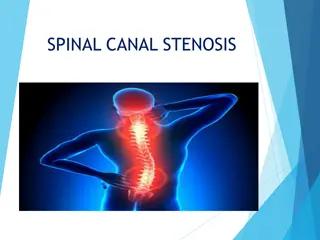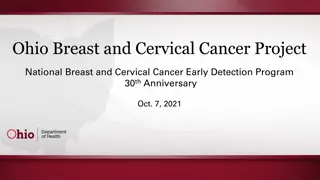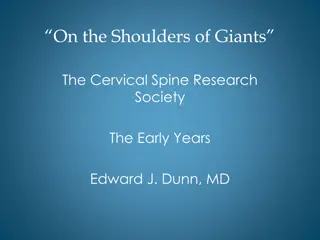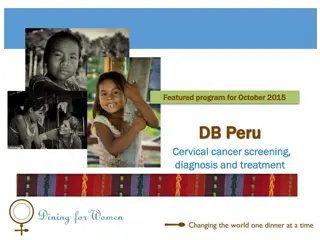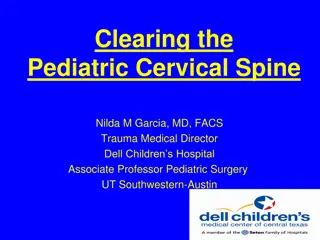Cervical Dysplasia: Causes, Symptoms, and Risk Factors
Cervical dysplasia refers to precancerous changes in cervical cells, commonly caused by the human papillomavirus (HPV). Learn about the causes, symptoms, and risk factors associated with this condition, including the importance of early detection and regular screenings to prevent the progression to cervical cancer.
Download Presentation

Please find below an Image/Link to download the presentation.
The content on the website is provided AS IS for your information and personal use only. It may not be sold, licensed, or shared on other websites without obtaining consent from the author.If you encounter any issues during the download, it is possible that the publisher has removed the file from their server.
You are allowed to download the files provided on this website for personal or commercial use, subject to the condition that they are used lawfully. All files are the property of their respective owners.
The content on the website is provided AS IS for your information and personal use only. It may not be sold, licensed, or shared on other websites without obtaining consent from the author.
E N D
Presentation Transcript
Maternal and neonate nursing nursing specialty Gynecological problems : . . .
Common gynecological problems include: 1-cervical dysplasia 2-menstrual disorders 3-plevic floor prolapse 4-polycystic ovarian syndrome 5-Endometrosis 6-infertilty
1-cervical dysplasia Cervical dysplasia refers to abnormal changes in the cells on the surface of the cervix. The changes are not cancer. But they are considered to be precancerous. This means they can lead to cancer of the cervix if not treated. It is also called cervical intraepithelial neoplasia(CIN). Strongly associated with sexually transmitted human papillomavirus (HPV)infection. Cervical dysplasia is most common in women under age 30 but can develop at any age.
causes 1-Cervical dysplasia is caused by the human papillomavirus (HPV). HPV is a common virus that is spread through sexual contact. HPV is usually passed from person to person during sexual contact such as vaginal intercourse, anal intercourse, or oral sex . But it also can be transmitted by any skin-to-skin contact with an infected person. Once established, the virus is capable of spreading from one part of the body to another, including the cervix. 2-Among women with a chronic HPV infection, smokers are twice as likely as nonsmokers to develop severe cervical dysplasia, because smoking suppresses the immune system. 3-chronic HPV infection and cervical dysplasia are also associated with other factors that weaken the immune system, such as treatment with immunosuppressive drugs for certain diseases or after an organ transplant, infection with HIV, the virus that causes AIDS.
Risk factors for cervical dysplasia 1-Persistent HPV infection is the most important risk factors for cervical dysplasia, especially moderate-to- severe cervical dysplasia. 2-Early initiation of sexual activity 3-Having multiple sex partners 4-Having a partner who has had multiple sex partners 5_Having sex with an uncircumcised man 6-Having a baby at very young age 7-Having other illnesses, such as tuberculosis or HIV 8-Using medicines that suppress your immune system 9-Smoking
symptoms Most of the time there are no symptom Exam and test Your health care provider will perform a pelvic exam to check cervical dysplasia . the initial test is usually a pap smear and a test for the presence of HPV. Cervical dysplasia that is seen on a pap smear is called squamous intraepithelial lesion (SIL) .ON the pap smear report ,these changes will be described as: 1-low grad (LSIL) 2-high-grade(HSIL) 3-possibly cancerous (malignant) 4-Atypical glandular cells(AGC) 5-Atypical squamous cells(ASC) *You will need more tests if a pap smear shows abnormal cell or cervical dyspasia. If the changes were mild, follow-up pap smear may be all that is needed. . The provider may perform a biopsy to confirm the condition
This may be done with the use of colposcopy.any areas of concern will be biopsied.the biopsies are very small and most women feel only a small cramp. Dysplasia that is seen on a biopsy of the cervix is called cervical intraepithelial neoplasia (CIN).it is grouped into 3 categories: CIN I mild dysplasia CIN II moderate to marked dysplasia CIN III severe dysplasia to carcinoma in situ
Treatment A-treatment depends on the degree of dysplasia. Mild dysplasia (LSIL or CINI) may go away without treatment. You may only need careful follow-up by your provider with repeat pap smear every 6 to 12 months. If the changes do not go away or get worse, treatment is needed. B-treatment for moderate-to-severe dysplasia or mild dysplasia that does not go away may include: Cryosurgery to freeze abnormal cells Laser therapy,which uses light to burn away abnormal tissue Leep(loop electrosurgical excision procedure), which uses electricity to remove abnormal tissue Surgery to remove the abnormal tissue (cone biopsy) Make sure to get the HPV vaccine when it is offered you. This vaccine prevents many cervical cancers
2-menstrual disorder Heavy or prolonged menstrual bleeding with intercourse, bleeding between periods and especially painful cramps can be signs of a menstrual disorder in women of menstruation age. Depending on the menstrual cycle problem or condition and the severity, medical or surgical intervention methods are available. Types of menstrual disorders: Premenstrual syndrome(PMS) Amenorrhea Dysmenorrhea Menorrhagia
Premenstrual syndrome(PMS) PMS is any unpleasant or uncomfortable symptom during your cycle that may temporarily disturb normal functioning. These symptoms may last from a few hours to many days, and the types and intensity of symptoms can vary in individuals. The most common symptoms of PMS can include any of the following: Psychological symptoms (depression, anxiety, irritability) Skin problems(acne) Headache Muscle spasms Infections Changes in appetite Fluid retention(swelling of fingers, ankles and feet)
Amenorrhea Amenorrhea is characterized by absent menstrual periods for more than three monthly menstrual cycles. there are two types of amenorrhea: Primary amenorrhea: menstruation does not begin at puberty. Secondary amenorrhea: normal and regular menstrual periods which become increasingly abnormal cause typically of later onset.
Amenorrhea can occur for a number of reasons as part of the normal course of life , such as pregnancy, breast-feeding or menopause. It may occur as a result of medications or medical problem including: Birth defect, anatomical abnormality or other medical condition Eating disorder Obesity Thyroid disorder Ovulation abnormality
Dysmenorrhea Dysmenorrhea is characterized by severe and frequent menstrual cramps and pain associated with menstruation. Causes 1-pelvic inflammatory disease(PIM) 2-uterine fibroids 3-abnormal pregnancy(miscarriage, ectopic ) 4-infection,tumors
Symptoms Cramping or pain in the lower abdomen Low back pain or pain radiating down the legs Nausea Vomiting Diarrhea Weakness Fainting headaches
menorrhagia Menorrhagia is the most common type of abnormal uterine bleeding and is characterized by heavy and prolonged menstrual bleeding. Other types of this condition, also called dysfunctional uterine bleeding, may include: Polymenorrhea: too frequent menstruation. Oligomenorrhea: infrequent or light menstrual cycles Metrorrhagia:any irregular, non-menstrual bleeding as in bleeding which occurs between menstrual periods. Postmenopausal bleeding: any bleeding that occurs more than one years after the last normal menstrual period at menopause
Causes: Hormonal imbalance Pelvic inflammatory disease (PID) Uterine fibroids Abnormal pregnancy; i.e., miscarriage, ectopic (tubal pregnancy) Infection, tumors or polyps in the pelvic cavity Certain birth control devices; i.e. intrauterine devices (IUDS) Bleeding or platelet disorders. High levels of prostaglandins (chemical substances used to control muscle contractions of the uterus) Liver, kidney or thyroid disease
Treatments for menstrual disorders Diuretics Prostaglandin inhibitors Hormone supplements Oral contraceptives Vitamin or mineral supplements Dietary modifications Anti depressant regular exercise
3-Pelvic organ prolapse Pelvic organ prolapse occurs when a pelvic organ-such as your and bladder-drops(prolapses) from its normal place in your lower belly and pushes against the wall of your vagina. This can happen when the muscles that hold your pelvic organs in place get weak or stretched from childbirth or surgery. More than one pelvic organ can prolapse at the same time. organs that can be involved when you have pelvic prolapse include the: Bladder. This is most common kind of pelvic organ prolapse. Urethra. Uterus . Vagina. Small bowel. Rectum.
causes Pelvic organ prolapse can be made worse by anything that puts pressure on your belly, such as: Being very overweight (obesity) A long-lasting cough Frequent constipation Pelvic organ tumors
symptoms Feeling pressure from organ pelvic organs pressing against the vaginal wall. this is the most common symptom. Feeling very full in your lower belly Feeling as if something is falling out of your vagina Feeling a pull or stretch in your groin area or pain in your lower back Releasing urine without meaning to(incontinence), or needing to urinate a lot Having pain in your vagina during sex Having problems with your bowels , such as constipation
Treatments A-nonsurgical treatments Pessary. This is probably one of the first treatments your doctor will recommend if you have symptoms of POP. Kegel exercises. These strengthen your pelvic muscles. Ther re very easy to do. Imagine you have to pee, but instead of letting it out, you squeeze to hold it. Do this for 5 seconds, relax, then do it again. Do 10 sets of these up to 15 times per day. Over time, your prolapse may get better or disappear altogether. Biofeedback therapy. This treatment combines teaching you how to contract your pelvic muscles with proper breathing techniques and abdominal control.
B- surgical treatment If your symptoms are severe and nonsurgical treatments haven t helped, you may want to consider surgery. There are two types of prolapse surgery: obliterative and reconstructive. Obliterative surgery narrows or closes off part or all of the vagina. the goal is to provide more support to the organs that have dropped out of their normal positions and are pressing against the walls of the vagina. This may be an option if surgery hasn t worked and you can t tolerate another procedure. After this operation you will no longer be able to have sex. Reconstrictive surgery aims to repair the pelvic floor and return organs to their original position. this can be done with cuts either in the vagina or the abdomen. It can also be done using laparoscopic surgery, in which a surgeon makes smaller cuts in the abdomen and uses special instruments.
4-Polycystic ovary syndrome (PCOS) The cause of PCOS is not fully understood, but genetics may be a factors. PCOS seems to run in families, so your chance of having it is higher if other women in your family have it or have irregular periods or diabetes. Can cause problems with your periods and make it difficult to get pregnant. PCOS also may cause unwanted changes in the way you look. If it is not treated, over time it can lead to serious health problems, such as diabetes and heart disease. Most women with PCOS grow many small cysts on their ovaries. That is why it is called polycystic ovary syndrome. the cysts are not harmful but lead to hormone imbalances.
Early diagnosis and treatment can help control the symptoms and prevent long-term problems. The cause of PCOS is not fully understood, but genetics may be a factor PCOS seems to run in families, so your chance of having it is higher if other women in your family have it or have irregular periods or diabetes
Symptoms Acne. Weight gain and trouble losing weight. Extra hair on the face and body. Often women get thicker and darker facial hair and more hair on the chest, belly, and back. Thinning hair on the scalp Irregular periods. Often women with PCOS have fewer than nine periods a year. Some women have no periods. Other have very heavy bleeding. Fertility problems. Many women who have PCOS have trouble getting pregnant (infertility) Depression
management Certain lifestyle changes, such as diet and exercise, are considered first-line treatment for adolescent girls and women with polycystic ovarian syndrome (PCOS).pharmacologic treatments such as, hirsutism, and menstrual irregularities. Medications for such conditions include oral contraceptives, metformin, predinsone, leuprolide, clomiphene and spironolactone.
5-Endometriosis Endometriosis happens when tissue normally found inside the uterus grows in other parts of the body. It may attach to the ovaries, fallopian tubes, the exterior of the uterus, the bowel, or other internal parts. As hormones change during the menstrual cycle, this tissue breaks down and may cause pain around the time of your period and long term painful adhesions or scar tissue. More than 5.5 million American women have symptoms of endometriosis.
Types Superficial peritoneal lesion.This is the most common kind. You have lesions on your peritoneum, a thin film that lines your pelvic cavity. Endometrioma (ovarian lesion).These dark, fluid-filled cysts, also called chocolate cysts, form deep in your ovaries. They don t respond well to treatment and can damage healthy tissue. Deeply infiltrating endometriosis.This type grows under your peritoneum and can involve organs near your uterus, such as your bowels or bladder. About 1% to 5% of women with endometriosis have it.
Stages Stage I (minimal).You have a few small lesions but no scar tissue. Stage II (mild).There are more lesions but no scar tissue. Less than 2 inches of your abdomen are involved. Stage II (moderate).The lesions may be deep. You may have endometriomas and scar tissue around your ovaries or fallopian tubes. Stage IV (severe).There are many lesions and maybe large cysts in your ovaries. You may have scar tissue around your ovaries and fallopian tubes or between your uterus and the lower part of your intestines. The stages don t take pain or symptoms into account. For example, stage I endometriosis can cause severe pain, but a woman who has stage IV could have no symptoms at all.
symptoms Back pain during your period Severe menstrual cramps Pain when pooping or peeing, especially during your period Unusual or heavy bleeding during periods Blood in your stool or urine Diarrhea or constipation Painful sex Fatigue that won t go away Trouble getting pregnant
Causes Doctors don't know why endometrial tissue grows outside of the uterus, but they have several theories. Heredity plays a role, and some endometrial cells may be present from birth. Another theory suggests that menstrual blood containing endometrial cells flows back through the fallopian tubes and into the pelvic cavity instead of out of the body. These cells are thought to stick to organs and keep growing and bleeding over time. Cells could also move to the pelvic cavity other ways, such as during a C-section delivery. A faulty immune system may fail to get rid of the misplaced cells.
Diagnosis When the pain happens How bad it is How long it lasts A change or worsening of pain Pain that limits your activities Pain during sex, bowel movements, or urination Pelvic Exam Your doctor will do a pelvic exam to check your ovaries, uterus, and cervix for anything unusual. An exam can sometimes reveal an ovarian cyst or internal scarring that may be due to endometriosis. The doctor also looks for other pelvic conditions that could cause symptoms similar to endometriosis.
Pelvic Scans Although it isn't possible to confirm endometriosis with scanning techniques alone, your doctor may order an ultrasound, CT scan, or MRI to help with diagnosis. These may be able to detect larger endometrial growths or cysts. The scans use sound waves, X-rays, or magnetic fields with radiofrequency pulses to create the images. Laparoscopy Laparoscopy is the only sure way to determine if you have endometriosis. A surgeon inflates the abdomen with gas through a small incision in the navel. A laparoscope is a viewing instrument that's inserted through the incision. The surgeon can take small pieces of tissue for a lab to examine -- called a biopsy -- to confirm the diagnosis.
Treatments Treatments usually include surgery or medication. You might need to try different treatments to find what helps you feel better. Pain medicine.Your doctor may recommend an over-the- counter pain reliever. Non-steroidal anti-inflammatory drugs (NSAIDs) like ibuprofen (Advil,Motrin) or naproxen (Aleve) work for many people. If these don t relieve your pain, ask about other options. Some other things you can do at home may help with pain: Take warm baths. Put a hot water bottle or heating pad on your belly. Exercise regularly. Some women find that alternative therapies like acupuncture, diet changes, or homeopathy work for them. Before starting one, talk to your doctor to be sure it won t interfere with another treatment.
Hormones.Hormonal therapy lowers the amount of estrogen your body creates and can stop your period. This helps lesions bleed less so you don t have as much inflammation, scarring, and cyst formation. Common hormones include: Birth control pills, patches, and vaginal rings Gonadotropin-releasing hormone (Gn-RH) agonists and antagonists such as elagolix sodium (Orilissa) or leuprolide (Lupron) Progestin-only contraceptives Danazol (Danocrine) Surgery.Your doctor might recommend surgery to take out as much of the affected tissue as possible. In some cases, surgery helps symptoms and can make you more likely to get pregnant. Your doctor might use a laparoscope or do a standard surgery that uses larger cuts. Pain sometimes comes back after surgery. In the most severe cases, you may need a surgery called a hysterectomy to take out your ovaries, uterus, and cervix. But without them, you can t get pregnant later.
5-infertility Revers to the inability of couples to conceive a clinical pregnancy after 1 year or more of trying. Failure to conceive within 2 years of regular unprotected intercourse
Causes in men : 1- semen and sperm Low sperm count: the man ejaculate a low number of sperm. A sperm count of under 15 million is considered low. Around one third of couples have difficulty conceiving due to a low sperm count. Low sperm mobility (motility): the sperm cannot swim as well as they should to reach the egg. Abnormal sperm: the sperm may have an unusual shape, making it harder to move and fertilize an egg.
2-impaired delivery of sperm Sexual issues Retrograde ejaculation Blockage of epididymis or ejaculatory ducts No semen (ejaculate) Hypospadias Anti-sperm antibodies Cystic fibrosis
Other causes may include Chemotherapy: some types may significantly reduce sperm count. Age: male fertility starts to fall after 40 years. Exposure to chemicals: pesticides, for example may increase the risk. Excess alcohol consumption: this may lower male fertility. Moderate alcohol consumption has not been shown to lower fertility in most men, but it may affect those who already have a low sperm count. Overweight or obesity: this may reduce the chance of conceiving. Mental stress: stress can be a factor, especially if it leads to reduced sexual activity.
Causes in women Age: the ability to conceive starts to fall around the age of 32 years. Smoking: Smoking significantly increase the risk of infertility in both men and women. Smoking during pregnancy increases the chance of pregnancy loss. Alcohol: any amount of alcohol consumption can affect the chances of conceiving. Overweight: this can increase the risk of infertility in women as well as men. Eating disorders: if an eating disorder leads to serious weight loss, fertility problems may arise. Diet: A lack of folic acid, iron ,zinc and vitamin B-12 can affect fertility
Exercise: little exercise can lead to fertility problems. Sexually transmitted infections( STIS): chlamydia can damage the fallopian tubes in a women . Some other STIs may also cause infertility. Exposure to some chemicals Mental stress: this may affect female ovulation and male sperm production and can lead to reduced sexual activity
Treatments Medications, treatments, and drugs: Non-steroidal anti-inflammatory drugs (NSAIDS): long-term use of aspirin or ibuprofen may it harder to conceive. Chemotherapy: some chemotherapy drugs can result in ovarian failure. In some cases, this may be permanent. Radiation therapy: if this is aimed near the reproductive organs, it can increase the risk of fertility problems. Illegal drugs: some women who use marijuana or cocaine may have fertility problems. Frequency of intercourse The couple be advised to have sexual intercourse more often around the time of ovulation. Sperm can survive inside the female for up to 5 days, while an egg can be fertilized for up to 1 day after ovulation. In theory, it is possible to conceive on any of these 6 days that occur before and during ovulation.
fertility treatments for men Erectile dysfunction or premature ejaculation: medication, behavioral approaches, or both may help improve fertility. Varicocele: surgically removing a varicose vein in the scrotum may help. Blokage of the ejaculatory duct: sperm can be extracted directly from the testicles and injected into an egg in the laboratory. Retrograde ejaculation: sperm can be taken directly from the bladder and injected into an egg in the laboratory. Surgery for epididymal blockage: A blocked epididymis can be surgically repaired. The epididymis is a coil-like structure in the testicles which helps store and transport sperm. If the epididymis is blocked, sperm may not be ejaculated properly.
Fertility treatmemts in the women Clomifene (clomid,serophene): this encourages ovulation in those who ovulate either irregular or not at all, because of PCOS or another disorder. It makes the pituitary gland release more follicle-stimulating hormone(FSH) and luteinzing homone (LH). Metformin(glucophage): if clomifene is not effective, metformin may help women with PCOS, especially when linked to insulin resistance. Human menopausal gonadotropin: or (repronex): this contain both and FSH and LH. Patients who do not ovulate because of a fault in the pituitary gland may receive this drug as an injection. Follicle-stimulating hormone(Gonal-f,bravelle): this hormone is produced by the pituitary gland that controls estrogen production by the ovaries. It stimulates the ovaries to mature egg follicles.
Human chronic gonadotropin(ovidrel,pregnyl): used together with clomiphene, HMG and FSH, this can stimulate the follicle to ovulate. Gonadotropin-releasing hormone (GN-RH) analogs:these can help women who ovulate too early before the lead follicle is mature during HMG treatment. Bromocriptine (parlode): this drug inhibits prolactin production.
References 1-American college of obstetricians and gynecologists. Practice bulletin no. 168: cervical cancer screening and prevention. Obstetrics gynecol.2016 2- Sarah A. Marshall, MD- family medicine & Divya gupta , MD-obstetrics and gynecology, gynecologic Oncology 3-infertility: an overview-A guide for patients. American society for reproductive Medicine. Accessed may 23, 2016.




